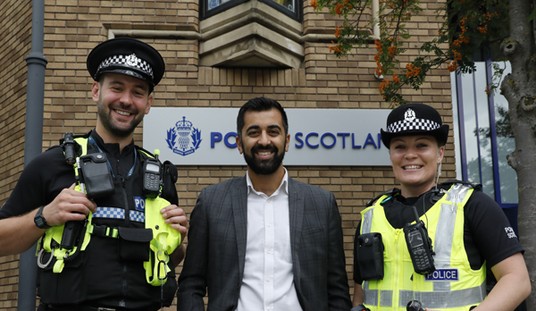It only took ’em a year to tweak the six-foot recommendation, which is based on no hard science and contradicts the WHO’s conclusion that three feet of spacing is sufficient. And yet that guidance was used by school districts across the country to justify limiting classroom instruction, doing developmental damage to hundreds of thousands of kids. If not for the political pressure generated by the recent study out of Massachusetts confirming that there was no meaningful difference in risk to students at three feet instead of six feet, the CDC might still be hesitating on loosening their recommendation.
I’d love to know how long the CDC has been debating this rule change behind the scenes before finally finding the nerve to pull the trigger. Weeks? Months? Fauci all but guaranteed last weekend that the guidance would change soon. Like I said a few days ago, bureaucratically things often seem to happen during the pandemic before they officially happen. It was clear that the guidance would be updated to greenlight three feet of spacing at some point but that was going to happen on the CDC’s schedule, not on the schedule of kids whose education urgently needs to resume.
Anyway. This is big news, as it’ll make things less comfortable for another underperforming, famously sclerotic bureaucracy. America’s public-school system and its employees now have one less excuse for limiting in-class instruction. Tighter spacing means more kids should be allowed in class, at least in communities where the virus isn’t raging.
The CDC said Friday that most of the school-based infections have been between adults, or between students and staff. Therefore, it recommends six feet of distance between students and their teachers and among teachers and staff. But the CDC said the rules can be relaxed for student-to-student interactions.
For elementary schools, it said, three feet of distance among students is sufficient no matter what the infection rates are in the surrounding community. Young children are much less likely to have severe cases of covid-19, and some research suggests they spread the coronavirus less efficiently than adolescents and teens.
The recommendations are more complex for middle and high schools and depend on which of four levels of community transmission are present in the surrounding area. At the three lowest levels, the CDC says three feet of distance is sufficient for all schools. But at the highest tier, the agency recommends six feet—meaning schools would likely have to rotate students in a hybrid system.
Our friends at the teachers unions are naturally indignant at being asked to do their jobs. “We need to make sure that before we do any changing or easing up of the mitigation strategies that we are making sure we have evidence from those diverse populations,” said the head of the NEA to WaPo about urban schools, where there’s less classroom space. Randi Weingarten, the president of the AFT, is also opposed:
I think that is problematic until we have real evidence in these harder-to-open places about what the effect is. https://t.co/irMfsLG12w
— Randi Weingarten (@rweingarten) March 19, 2021
It’ll never be enough. CDC reassurances of safety, vaccine prioritization for teachers — nothing’s going to get them back to class until the risk is zero. You either go the DeSantis route and start playing hardball or resign yourself to the fact that kids will be back in class when the unions say so and not a moment before. Last summer Florida’s education commissioner told schools to reopen five days a week or risk losing funding; the unions sued over that policy and lost, and so classroom instructed recommenced. Result: No superspreader events in the past seven months and more than 80 percent of Florida students back to class full-time.
Another likely component in the CDC’s decision today was the grim results of a new study it conducted to see what sort of effect the pandemic’s had on kids and their harried parents as they try to manage months without school:
Parents whose children attended either virtual or remote learning were more likely to report that they noticed worsening mental and emotional health (24.9 percent for remote parents, 15.9 for in-person parents)…
The new study also described how the pandemic has increased parental responsibility and stress, with many parents — mothers in particular — having to now juggle work and schooling. Indeed, the parents of students in remote educational arrangements were more likely to say that they were worried about losing their jobs (26.6 percent to 15.2 percent) or figuring out the ever-shifting puzzle that is pandemic childcare (13.5 percent to 6.8 percent) than were parents with in-person children.
And whereas only 38 percent of parents with students back in the classroom said they experienced high or moderate emotional distress, that share jumped to 54 percent for parents with children learning from home.
Kids learning from home are moving less too, which increases the risk of obesity and reduces opportunities for the mental-health benefits of exercise and socializing. The CDC may have finally, belatedly reached the conclusion that virtually all conservatives and even some liberals have arrived at, which is that the minor risks of infection inside schools don’t remotely justify the manifold human costs required to keep them closed.
We’ll see if this leads Biden to be a little more forceful with the unions about getting back to work. I’m not optimistic. Here’s Scott Gottlieb this morning wondering why the CDC is still farting around with “how many angels can dance on the head of a pin” debates involving minutiae about school operations when it should be focused on the spread of variants in the United States instead.
"This is what the CDC should be doing not still arbitrating 3 feet vs. 6 feet a year later. We should be on top of these new variants, evaluating what their clinical course is. We shouldn't have to wait months to get this information," says @ScottGottliebMD. pic.twitter.com/rcSnpGHaPl
— Squawk Box (@SquawkCNBC) March 19, 2021








Join the conversation as a VIP Member